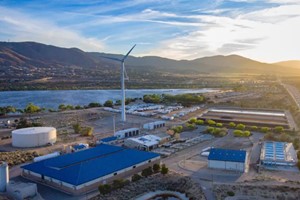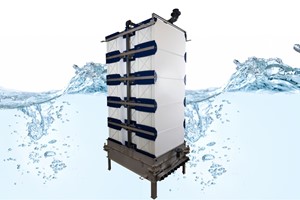Water pollution is an increasingly critical global issue, driven by rapid urbanization, agricultural intensification, and industrial development. Many regions face challenges in treating and purifying contaminated water, with water utilities struggling to meet the rising demand for clean water. In response, Filtralite, a high-porosity filter media developed by Leca, has emerged as a solution. By retaining more contaminants, Filtralite increases the efficiency of water filtration processes, making it a valuable tool for water utilities worldwide. Geir Norden, Research and Development (R&D) Expert at Filtralite, shares insights into how this innovative technology is revolutionizing water treatment and promoting sustainable water management.
Norden’s Background and Filtralite’s Role in Water Treatment
Geir Norden has been with Leca, Europe's leading producer of expanded clay, since 1995, when Filtralite was first introduced. Throughout his career, he has been deeply involved in the R&D of Filtralite, overseeing its development and ensuring that the product meets the evolving needs of the global water treatment market. As part of the Saint-Gobain Group, Filtralite aligns with the company’s mission to provide high-performance products that enhance comfort and security for its customers. Saint-Gobain is well-known for its sustainable and innovative solutions, and Filtralite fits into this portfolio by offering a filter media designed to reduce operational costs and enhance filtration efficiency.
Addressing Global Water Challenges
Water utilities around the world face different challenges when it comes to providing clean water. Some regions focus on improving water quality, while others are concerned with increasing water production. A growing number of utilities are also seeking to reduce water consumption and operational costs. Filtralite offers a versatile solution with its range of products—Filtralite Pure, Filtralite Clean, and Filtralite Air—catering to diverse water treatment needs, including drinking water, wastewater, and even air filtration. Norden explains that by tailoring their solutions to specific market requirements, Filtralite can help utilities tackle unique water challenges in different parts of the world.
One of the key advantages of Filtralite is its higher porosity compared to traditional sand filters. With 61% of its volume consisting of voids, Filtralite can capture and retain more suspended solids, improving filtration efficiency. This allows utilities to filter larger volumes of water with the same amount of filter media, reducing the frequency of backwashing—an energy-intensive process that cleans the filters and restores their capacity. The reduction in backwash frequency leads to significant savings in water, energy, and operational costs for utilities.
Adapting to Diverse Global Markets
One of the main challenges Filtralite faces is its global reach. The company exports its products to a wide range of markets, including Australia, South America, and South Korea. Each region employs different methods for treating drinking water and wastewater, requiring Filtralite to develop filter materials with varying particle densities and sizes to accommodate diverse filtration processes. Norden notes that this flexibility allows Filtralite to effectively filter different types of water and address various forms of water pollution, making it a global solution to a global problem.
To ensure that Filtralite’s innovations meet the needs of the market, the company collaborates closely with external partners, including universities and water utilities. Many customers conduct their own internal testing of Filtralite in their laboratories, and the company works with leading water utilities such as Suez, Aqualia, and Saur to evaluate its performance. Filtralite also supports PhD students in researching filtration media and methods to reduce energy consumption during the filtration process, ensuring that the product remains at the forefront of water treatment technology.
Effective Contaminant Removal and Real-World Success Stories
Filtralite’s filter media is effective in removing a wide range of pollutants, including iron, manganese, ammonia, total organic carbon (TOC), and arsenic. In Helsinki, Finland, Filtralite was used to replace sand in the water treatment plant at Jäniksenlinna. The plant had been using sand filters that required backwashing every two days. After switching to Filtralite, the frequency of backwashing was reduced to once a week, while maintaining the same level of iron and manganese removal.
Another notable success story comes from the Philippines, where the drinking water plant in Putatán II, near Manila, was struggling with high levels of ammonium. The plant initially relied on chlorination to remove the ammonium, but the process required 15 tonnes of chemicals every day, which was both costly and difficult to manage. After conducting tests with Filtralite, the plant switched to aerated biofiltration, eliminating the need for chemicals and significantly reducing operational costs. This transition not only lowered costs but also minimized the environmental impact of the plant by reducing the use of chemicals.
Reducing Energy Consumption and Carbon Footprint
Energy consumption is a major operating cost for water treatment plants, and Filtralite’s high porosity helps reduce this burden. By capturing more suspended solids, Filtralite reduces the need for frequent backwashing, cutting water and energy consumption. Norden points out that Filtralite can reduce backwash costs by three to four times compared to traditional sand filters, leading to substantial savings for water utilities. In addition, the media’s ability to filter larger volumes of water more efficiently helps utilities lower their overall energy consumption.
Filtralite also contributes to reducing the carbon footprint of water treatment plants. Saint-Gobain’s sustainability strategy includes factoring in a CO2 price for each project, which encourages the development of solutions that minimize emissions. For example, Filtralite has replaced coal with biomass in its production process, cutting CO2 emissions by 50%. The lightweight nature of Filtralite also reduces transportation emissions, as more filter media can be transported in a single load, further lowering the carbon footprint.
In desalination plants, Filtralite extends the lifespan of reverse osmosis (RO) membranes, allowing for higher levels of suspended solids in the inlet water. This capability has proven particularly beneficial in locations such as Beni Saf, Algeria, where the plant can continue operating even during periods of heavy rainfall when suspended solids levels are high. This improved performance reduces the need for plant shutdowns, ensuring a consistent supply of clean water.
A Bright Future for Water Treatment
Looking ahead, Norden sees a growing demand for Filtralite as urbanization, population growth, and stricter water treatment regulations drive the need for more efficient water filtration solutions. In regions facing water scarcity, Filtralite’s ability to increase filtration rates without requiring new infrastructure makes it a valuable tool for conserving water resources. Moreover, as energy costs continue to rise and concerns about climate change intensify, Filtralite’s energy-saving and carbon-reducing benefits will become even more important for water utilities worldwide.
Filtralite’s innovative filter media offers a sustainable and cost-effective solution to the challenges of water pollution and filtration. With its ability to capture more contaminants, reduce energy consumption, and lower operational costs, Filtralite is poised to play a key role in the future of water treatment globally.











